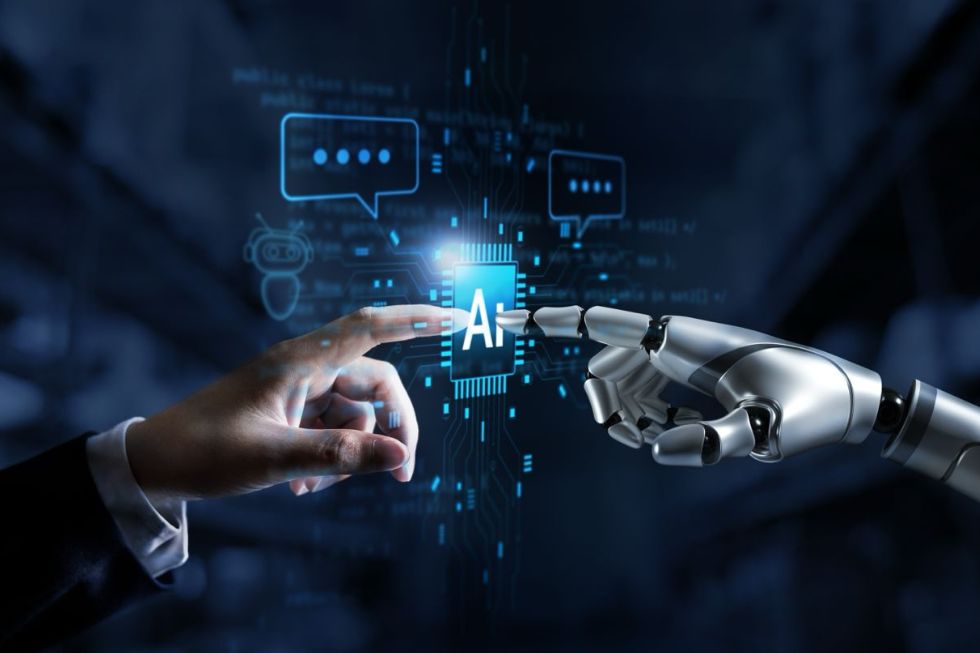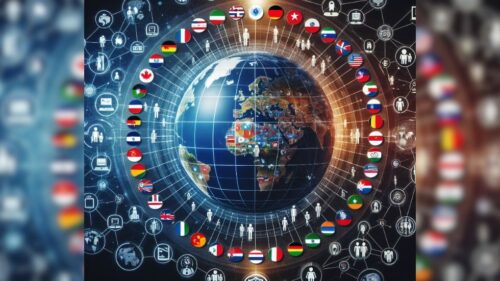Our global society is going through a difficult period that is producing a lot of anxiety, alienation and anger. What underlies these negative feelings is a social transition known as an inflection point, or a shift from a culture based on one set of technologies to another. An inflection point is not the beginning or end of the transition. Rather, it is the point where change is widely felt to be inevitable. Currently, the inflection point we are experiencing is the shift from a mechanical society to a cyber society accelerated by the advent of generative AI, or GenAI.
Understanding this particular inflection point will help us find tangible, active ways to reassure people that they will not be unduly hurt as the transition progresses, thereby reducing the worst of the negative feelings that can otherwise lead to serious cultural and social damage. If we find a good way to do that and implement it in time, we can deal with every other challenge we face.
The shift to a cyber society dismantles culture as we know it
Inflection points bring with them significant cultural changes. Social anchors individuals held onto in times of trouble may no longer be the stable points they once were. This is what is causing the level of anxiety, alienation and anger we are seeing. Some historians suggest that the US Civil War was driven by similar feelings around the inflection point between an agricultural and an industrial society.
As we traverse the inflection point from a low variable, highly standardized mechanical culture to a high variable, cyber-influenced one, there can only be further insecurity. Our culture is highly dependent on the kind of technology we use, so a shift in technology means a shift in culture. In the recent past, our culture reflected mechanical technology. Mechanical technology requires no variability and only needs a limited number of standards, such as uniform gears in a machine. This sense of limited variability around a few well-developed standards pervades a mechanical culture. This leads to a limited number of standardized religions, political parties, genders and gender roles.
In contrast, cyber technology does not require the same kind of limited variability. In place of standardized gears, cyber operates on well-defined interfaces, places where independent systems meet and communicate with each other. A multitude of systems are allowed as long as they have well-defined interfaces. This leads to a profusion in the number of religions, political parties and even genders as our society begins to reflect cyber technology. One example is the “interface” identification seen in the underground gay community of years past. Different colored handkerchiefs worn in different pockets helped identify which of the profusion of genders a person was. The same goes for professions and political parties. In the last US presidential election, more voters identified as independent than as members of one of the two key parties.
Social changes are increasing rapidly
The current inflection point anxieties are compounded by the appearance of GenAI in nearly all sectors of society from public to private. A friend of mine once characterized GenAI as a newborn baby just leaving the hospital. As a society, we are just beginning the process of figuring out how to use it. However, it is increasing in power and profusion rapidly. The economic benefits behind GenAI are so substantial that deployment of the technology – and by extension, cyber society – can’t be stopped. To understand the extent of the transition to a cyber society, it can be helpful to look at a few examples.
Farmers who never touch dirt
Looking down the road, we can envisage a farmer who never touches dirt. Farmers would work from an office and order autonomous vehicles to perform common farming tasks such as maintaining the irrigation, planting seeds, harvesting, and delivering the harvest to a buyer. Eventually, the farmer doesn’t even have to sit at a computer. GenAI agents will take over actions such as choosing planting dates, types of crops, and even specific vendors and buyers. At the final stage, the farmer may not even own land. In a further effort to break up vertical integration, GenAI will choose where to grow crops and even arrange to rent land in the chosen area. An automated farming project called Roboton Farmer is already underway – automation is moving fast.
Scientific research and software development
A study reported that more than 17.5% of recent papers submitted to scientific journals have been written by GenAI. Also, GenAI has written between 6.5% to 16.5% of the peer review analyses supposedly written by the experts who determine if the papers are suitable for publication. Soon, GenAI will do the research itself. In addition, GenAI is already creating software. My programmer friends consider the results are, at best, a good first draft that still requires manual effort to get it good enough to put in production. Over time, GenAI software quality will improve as the technology matures. We will see large critical systems running on GenAI-created software. Eventually, some say, GenAI will create the next generation of AI systems.
Restaurants
In Japan, a declining population is driving the need for automation. Currently there are even some restaurants with no waiters or waitresses. While there are still human kitchen staff, all customer service is reliant on robots. At each table there is a small robot that takes orders and payment. Another robot delivers the food. In the future, GenAI will look at the customers and listen to their voices, deciding based on what they see and hear what kind of food to recommend. The kitchen will also be automated by GenAI agents and the possible menu of dishes will be quite large.
Of course, these are projections. Noncentralized agents powered by GenAI are just beginning to appear. However, these agents will undoubtedly turbocharge existing automation trends and cause far-reaching effects well beyond what has previously been considered. The full extent is not clearly foreseeable yet. But enough is visible that anxiety surrounding the shift is already being felt on all levels, from individual to global. Even nations are beginning to feel the strain.
On the international stage, a cyber society means shifts in relations
Individuals rely on their nation for security against other nations coming and taking things away. In a mechanistic world, to avoid being a loser, a nation has to have the ability to produce the machinery of war as fast as or faster than other nations. This requires a large nation with large quantities of natural and human resources. However, the way conflicts are conducted is changing. Smart weapons are more effective than big machines. In Ukraine, drones costing a couple of hundred dollars are defeating multi-million dollar tanks. Cyber weapons are already appearing on the Ukraine battlefield.
In a cyber society, it is the ability to “out-think” rather than “overpower” that wins. As our quality of life, and sometimes survival, depends more and more on cyber systems, protecting them from cyber attack becomes critical. The rapid increase in successful cyber crime has urged nations to turn to the development of chip and software technology. Instead of extensive factories, think tanks and technology development companies provide the basis for a strong economy.
Focus on cyber development means that large nations may no longer be critical to national security. The city state of Singapore may be the model of the future. For example, some point to the fact that the San Francisco Bay Area, if measured as a nation state, would be the 5th largest economy in the world. Such a shift will allow smaller, developing countries to build stronger economies and establish larger global presences. However, this leads to more anxiety for the nations that already have powerful global presences.
Limiting damage must be our top priority
Unfortunately, the economic and technical forces that drive these transformations can’t be reversed. Anxiety and alienation create a desire to stop the inevitable, but the impossibility of that creates dangerous levels of anger. People begin to act out in personally, socially and politically destructive ways. Acting out can lead to further anxiety, alienation, fear and anger. If proper steps are not taken, it can lead to a vicious cycle.
The question that confronts us at this inflection point is, how can we get through this transition while minimizing the amount of damage we suffer? It seems that there is only one approach that can work: to provide the assurance that a respectful quality of life will be maintained even after such a large-scale social transition.
However, many people will not accept simple assurances, especially since experts’ assurances don’t often match with their lived experiences. Economist Paul Krugman, in a recent interview discussing his work on globalization, said that he made a big mistake. He had looked at the number of job losses in the context of the whole US economy and concluded that they were not significant. His mistake was that he didn’t recognize that the job losses would not be uniformly distributed. That they would be concentrated in specific towns or communities, and as such, those communities would be irrevocably devastated.
These people need to see concrete action. We must have a way of picking them up before they fall and doing so in a way that makes them feel good about themselves. The difference in economic histories and cultures may influence what is realistically achievable, so concrete action must be done in ways that are compatible with local conditions. Whether directly or through a transition process, different solutions may be needed in different parts of the world. This is the most important challenge we face in a world full of them.
The views expressed in this article are the author’s own and do not necessarily reflect Fair Observer’s editorial policy.
Support Fair Observer
We rely on your support for our independence, diversity and quality.
For more than 10 years, Fair Observer has been free, fair and independent. No billionaire owns us, no advertisers control us. We are a reader-supported nonprofit. Unlike many other publications, we keep our content free for readers regardless of where they live or whether they can afford to pay. We have no paywalls and no ads.
In the post-truth era of fake news, echo chambers and filter bubbles, we publish a plurality of perspectives from around the world. Anyone can publish with us, but everyone goes through a rigorous editorial process. So, you get fact-checked, well-reasoned content instead of noise.
We publish 3,000+ voices from 90+ countries. We also conduct education and training programs
on subjects ranging from digital media and journalism to writing and critical thinking. This
doesn’t come cheap. Servers, editors, trainers and web developers cost
money.
Please consider supporting us on a regular basis as a recurring donor or a
sustaining member.
Will you support FO’s journalism?
We rely on your support for our independence, diversity and quality.








Comment